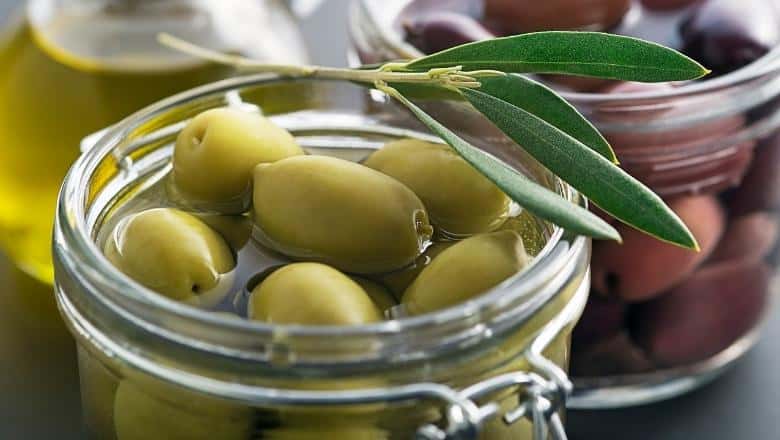Table Olives vs. Oil Olives: What’s The Difference?
Olive Knowledge is a part of Amazon Associates. As an Amazon Associate, we earn from qualifying purchases. Read our Affiliate Disclosure to learn more.
There are two main types (categories) of olives: table olives and oil olives. In this post, I’ll show you their differences so that you know which ones to use for what purposes. If you’re an olive grower or want to become one, this post might be very helpful to you.
Key Takeaways:
- Table olives and oil olives differ mainly in size, oil content, and intended use.
- Table olives have larger fruit, lower oil content, and are meant for direct consumption.
- Oil olives have smaller fruit and higher oil content and are used for olive oil production.
- Olive oil types include Extra Virgin, Virgin, Regular, and Olive Pomace Oil.
- Despite differences in use, table and oil olives have similar organoleptic properties.
Table Olives Explained

Table olives are olive tree fruit that is meant to be consumed as food. The varieties of olives for producing table olives are wisely chosen. Those varieties of olives must be cultivated and particularly suited to curing. Another essential point is a suitable treatment table olive to be ready for final consumption.
Table olive production starts with selective fruit collection by hand from the olive trees. It’s hard to eat raw olives because of the oleuropein substance, causing a natural bitterness. Processing methods of table olives depend on variety, ripeness, and consumer habits. In order to preserve, table olives must be cured. That can be done in four ways: oil curing, water curing, brine curing, and dry curing.
Additionally, depending on the degree of ripeness of the fresh fruits, table olives can be classified in three ways:
- Treated green olives (Spanish-style green olives)
- Olives darkened by oxidation (ripe olives)
- Natural black olives
Table olives are one of the most important components of Mediterranean cuisine, but they are also very often used in cuisines worldwide. Usually, table olives are a famous ingredient for a typical Greek dinner. Table olives are worth fruit in the Mediterranean diet, and they add intensity and better visuality to a simple meal.
If you wondered where in the world the best olives are produced, here’s the answer. The world’s leading table olive producers are Spain, Egypt, Turkey, Argentina, and Syria. In Turkey, Morocco, and Greece, table olives are mostly consumed for breakfast or before/after meals. In comparison, Spain, Italy, and the USA tend to consume table olives as appetizers.
Common Varieties of Table Olives
It’s been estimated that 139 olive varieties grow in 23 countries around the world. On the market, they can be found in different forms: whole, stoneless, stuffed, salted, sliced, alcaparrado, mixed, and packed.
It is known worldwide that one of the best table olives is produced in Greece.
The top varieties that are used in their cuisine are:
- Kalamon variety – slightly bitter and particularly fruity taste
- Throumpa – black small size olives with a pleasant and natural taste with sea salt
- Chalkidiki – slightly tart, soft, full flavor
- Konservolia – soft flash with a mild flavor
- Thasos – salt-cured, black olives with a woodsy flavor
Oil Olives Explained

Oil olives are olive tree fruits that are meant to be consumed in olive oil. The process of olive oil production depends on the type of oil. The whole production process is divided into 4 phases: harvesting, washing, kneading, and extraction.
If you go to buy olive oil in a store, you will find four different types of olive oil:
- Extra Virgin Olive Oil
- Virgin Olive Oil
- Olive Oil
- Olive Pomace Oil
Firstly, the highest quality olive oil is Extra virgin olive oil which can be considered as pure olive juice without additives or preservatives. Secondly, Virgin olive oil is also pure olive juice that doesn’t contain additives or preservatives, but it shows some sensorial defects. Thirdly, regular olive oil is a mixture of refined and virgin olive oil, but it’s lower quality than extra virgin. Fourthly, olive pomace oil is the lowest quality olive oil, and it’s made from a mixture of refined pomace oil and virgin olive oil.
Common Varieties of Oil Olives
The very important component of producing olive oil is a variety of olives. All these varieties can produce extra virgin olive oil, and the secret is in the moment of picking.
Olive color depends on the time of picking. Generally, powerful olive oil is produced from greener, less ripe olives. That kind of olive oil has a stronger, peppery taste and higher antioxidant content. Milder, fruity-tasting oil is produced with olives that are harvested when ripe.
When you buy olives, you can always see green and black olives. People usually think that these are different kinds of olives, but no, they’re not. Color depends on the stage of ripeness.
According to producers, the best oil olives varieties are :
- Arbequina – yellow, slightly green with a buttered flavor and spicy finish
- Hojiblanca – golden color with a flavor that reminds of fresh grass
- Picual – bitter and spicy touches
- Cornicabra – the aroma that reminds of an apple with a slightly spicy touch
- Empeltre – yellow color and sweet taste
Related: Most Popular Olive Tree Varieties
The Difference Between Table and Oil Olives

If you’re wondering about trying different varieties and sizes of olives, it’s important to emphasize that there is no significant difference in organoleptic properties between oil olive and table olive.
Behind that, some producers are making a great difference between these two purposes olives are used for. For example, they want the olives that are chosen to be table olives that reach the proper degree of development. Their volume, shape, flesh ratio, and firmness make them appropriate for production.
Olives are green when they are unripe. As they ripen, the color progresses to black. At each stage of ripeness, olives taste different. We can conclude that every consumer needs to find the right olive oil and table olive taste for themself.
Conclusion
In the end, I’d like to mention that for most consumers, there won’t be any difference because you’re already provided with the best type of olives based on what you consume: whether it’s a brined olive or a bottle of olive oil.
But if you think about making your own olive oil or even making your own brined olives, knowing the difference may be extremely important because that will allow you to get the highest quality product.
Similar Posts:
